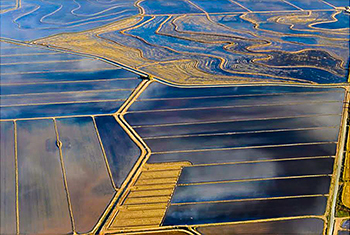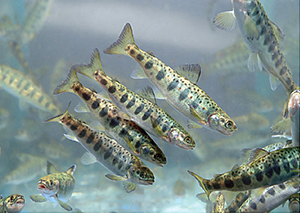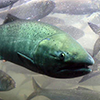The idea of rearing salmon in fallowed rice fields started in a duck blind. Huey Johnson, California’s Secretary of Resources in the 1970s and at age 82 widely considered the “grand old man” of California environmentalists, is an avid hunter, who has spent hundreds of hours in Central Valley duck blinds. It is perhaps a testament to the contemplation induced by extended time spent in blinds that Johnson, surrounded by winter rice fields flooded to decompose rice straw, began wondering what else could be done with all that water. His answer: Grow fish. With two environmentally minded investors, Johnson formed a company called Cal Marsh & Farm Ventures that in 2011 acquired a Northern California rice field to carry out fish experiments.

As it happened, in the late 1990s two scientific teams — one led by Ted Sommer, a floodplain biologist in California’s Department of Water Resources, and the other by Peter Moyle, a University of California, Davis, biologist and leading inland fish expert — had begun carrying out similar experiments in the Central Valley. They sent juvenile salmon downstream across floodplains instead of via rivers, where predators were more numerous. Their work showed that juvenile salmon diverted from the Sacramento River’s main channel and retained in its adjacent floodplain for a few weeks grew more than twice as fast as fish that stayed in the river.
In 2012 Cal Marsh & Farm Ventures and the scientists joined forces in the Nigiri Project, named after a kind of sushi because both combine rice and fish, to use rice fields to promote salmon restoration. The scientists have since compiled persuasive evidence that salmon benefit greatly by lingering in flooded rice fields, while Johnson has started another enterprise that uses rice fields to grow forage fish for protein.
There is persuasive evidence that salmon benefit greatly by lingering in flooded rice fields.
The salmon project is likely within a year or two of overcoming the last bureaucratic obstacles keeping it from operating as a government-sanctioned method of mitigating environmental harm. Though less-developed, the forage fish venture offers the prospect of global impact by taking pressure off of wild fish stocks. Both projects suggest the rising influence of “reconciliation ecology,” which argues for the reconfiguration of human-dominated landscapes to include other species as the only way left to sustain most ecosystems.

Two centuries ago the Central Valley was largely a marshy wetland. When the Sacramento River flooded, juvenile salmon beginning their journey downstream to the ocean were cast onto its floodplain, where they stayed for months, fattening themselves on plankton and insects that were part of the floodplain’s biological cornucopia. But the construction of ever-higher levees in the 19th century, vividly described in Robert Kelley’s 1989 classic Sacramento River history, Battling the Inland Sea, separated the Sacramento from its floodplain.
The result was that salmon were hurtled down the river’s main channel, reaching the Sacramento-San Joaquin River delta and the Pacific Ocean too early, when they were underweight and unprepared for predators. Combined with dams, gold mining, and water diversions for agriculture and municipal consumption, the river’s isolation from the floodplain has reduced three of the Sacramento’s four salmon runs to endangered levels.
Southeast Asians have raised fish in rice fields for many centuries, but they do it while the rice is growing, using fish suited to the paddy water’s warm temperatures. What distinguished Johnson’s idea from the traditional Asian practice was that he wanted to grow salmon in the winter, after rice was harvested and water temperatures were low enough for salmon. This wasn’t even possible until the early 1990s, when California’s clean air laws placed tight restrictions on burning rice straw, the farmers’ preferred method of eliminating rice residue.
Farmers then began flooding their fields starting in the late summer or fall, inadvertently producing a simulacrum of the vast 4-million-acre Central Valley wetlands that had existed two centuries ago. Winter-flooded Central Valley rice fields now cover a larger area — 250,000 to 300,000 acres — than the 200,000 acres of original valley wetlands that remain.
The switch to flooding has generated a huge resurgence of the Pacific Flyway, as millions of migratory birds desperate for water in the increasingly drought-prone valley began using the rice fields as way stations. Politically vulnerable because of their high use of water in an increasingly water-scarce state, rice farmers found themselves cast as environmental heroes, and embraced the herons, egrets, ducks, geese, sandpipers, and other birds that thronged to their fields. Rearing fish could add to the rice farmers’ environmental credentials while supplementing their incomes with mitigation fees paid by the state’s water users.
Rearing fish could add to the rice farmers’ environmental credentials while adding to their incomes.
The production of rice and fish on the same field is a prime example of reconciliation ecology, first articulated in a 2003 book called Win-Win Ecology: How the Earth’s Species Can Survive in the Midst of Human Enterprise. The author, Michael L. Rosenzweig, a University of Arizona ecologist, argues that humans have so thoroughly transformed the earth’s surface that environmental restoration is impossible on virtually all of it, and the few areas set aside as natural reserves aren’t big enough to sustain many species. Instead, he says, the only way to ward off mass extinctions is to convert working landscapes to support other species while continuing to fulfill human needs.
Reconciliation ecology represents a shift among environmentalists from focusing on a particular place, such as a nature reserve, to a natural process. “We invest a lot of money in postage-stamp, high-profile conservation efforts that really are just a blip on the larger landscape,” Jacob Katz, the Nigiri Project’s lead scientist, said. “Instead, we should be thinking about how water flows across the entire landscape and managing those natural processes so that basically the habitat takes care of itself.”
The juvenile salmon reared in the Nigiri Project may benefit rice fields as much as rice fields benefit them, while both foster the resurgence of the floodplain food web. Floodplains are much richer, more varied biological environments than rivers; reconnecting floodplains to rivers infuses downstream basins with life. Flooded rice fields awaken dormant plankton in the soil, insects flourish on the plankton, and the fish dine on both. In turn, the fishes’ presence reduces insects, weeds, and diseases that may harm rice.
Rice farming is often criticized for its sizable water use, but it’s the only crop that flourishes in the Sacramento Valley’s clayey soils. The clay holds back the water from percolating deeper into the soil and contains it in the fields until they’re drained in March.
If farming forage fish increases, it could reduce pressures on overfished ocean stocks.
As the water, now laden with nutrients and fertilizing fish excrement, makes its way down the basin and back into the river, it enriches the downstream environment all the way to the estuary, benefiting native fish there. Once the river reconnects with the floodplain, the Sacramento’s dwindling stock of wild salmon regains an edge over hatchery salmon, which scientists say could enable a resurgence of the genetically superior wild salmon.
A major liability of rice is that it’s the only agricultural crop whose production causes methane emissions, a process that was intensified by the use of Green Revolution chemical fertilizers. For that reason, the cultivation of rice, the staple of 3 billion people worldwide, is the leading agricultural source of greenhouse gas emissions. But fish in paddies reduce the need for chemical fertilizers without lowering rice productivity. Accordingly, as the United Nations Food and Agriculture Organization reported in 2012, “Rice-fish farming reduces the emission of methane by almost 30 percent compared with traditional rice farming.”
In 2010 Cal Marsh & Farm Venture’s managers — environmental land manager David Katz and rice farmer John Brennan — began what has been a five-year struggle to make floodplain restoration a key part of the management of the Sacramento River-San Joaquin River Delta. The project research so far has taken place in a Sacramento River floodplain known as the Yolo Bypass, through which water is diverted to avoid flooding Sacramento. First, Katz and Brennan encountered resistance from Yolo County officials, who feared that the project would destroy agriculture in the Bypass floodplain.
As more and more pieces of the project’s biological research confirmed that rice fields benefited from fish, Katz and Brennan held hundreds of meetings with Yolo County rice farmers to explain it, and eventually won them over. The pair overcame similar opposition from duck hunters.
Their last barrier, bureaucracy, may be the most formidable, for they’ve found that the regulatory zeal of government officials often stifles innovation. Though the project has no outright opponents and support from surprising places, including the Los Angeles Metropolitan Water District and the U.S. Bureau of Reclamation, it still needs state approval. Instead, Katz said, when project scientists applied to acquire hatchery salmon for the experiments, “Some government bureaucrat said, ‘Your people are not qualified under the permit to handle these fish.’ They said that to California’s leading salmon scientists! It was ludicrous!”

Despite that, the project is now a featured part of California EcoRestore, the state’s stripped-down proposal, announced last April, for restoring the severely impaired Sacramento-San Joaquin River delta. EcoRestore is less than the sum of its parts, for most of the projects it trumpets were started before the plan was even devised. The notable exception is the Nigiri Project.
“Here is a restoration effort which has the lowest uncertainty and highest return on investment of them all,” said Jeffrey Mount, an emeritus University of California, Davis, geomorphologist and a senior fellow at the Public Policy Institute of California. “The research that shows the use of the floodplain as rearing and spawning habitat for native fishes like the salmon is as solid evidence as you’re ever going to get — period.”
Johnson grew so frustrated with the bureaucratic obstacles that he turned over operation of the salmon project to Katz, Brennan, and CalTrout, a San Francisco-based nonprofit that supports research to help wild fish. Then he launched another fish-rice project, called “Fish in the Fields,” that attracts far less government scrutiny than the Nigiri Project, partly because its focus is unheralded forage fish, not charismatic salmon.
ALSO FROM YALE e360For California Salmon, Drought And Warm Water Mean Trouble

Johnson plans to use winter rice fields to grow small, non-native forage fish that can be harvested when the fields are drained. Then the fish can be turned into bait, livestock and poultry feed, pet food, fertilizer, dietary supplements, and food for humans. The fish would never reach the floodplain, let alone the river or ocean, but if plentiful enough they could generate another kind of environmental benefit, by reducing the intensifying pressures on overfished ocean stocks of sardines, anchovies, herring, and mackerel. At the same time, the project offers the possibility of an additional source of protein without requiring any more land, at a time when human demand for protein is growing and land-use conflicts are multiplying.
Johnson started his experiments in 2013 with 45,000 Arkansas golden shiners, a hardy minnow variety that grew prodigiously in early rice field experiments. Last month he finished building the nation’s first golden shiner hatchery in a rice field eight miles northeast of Marysville, California, and hopes to harvest its fish next spring. Because the fish are harvested much closer to consumers than the trawlers that collect ocean forage fish, they could be a cheaper and less-carbon-intensive source than the oceans. Johnson hopes his pilot project will prompt rice farmers around the world to enter the $5.6-billion global forage fish market.
“You essentially have new ecosystems that we’ve never had around before,” said Moyle, the dean of California fish biologists. “That makes them difficult to manage, but it’s also pretty exciting. You have to find ways to make working landscapes benefit fish and wildlife. It means everybody has to give up something, but in the long run everybody is better off.”